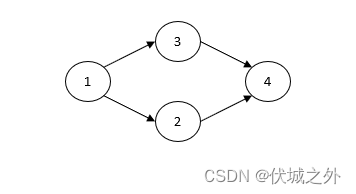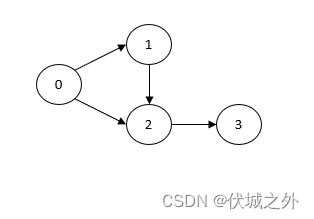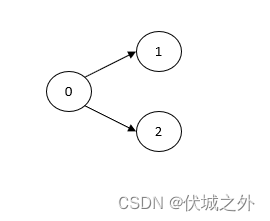题目描述
给定一个有向图,图中可能包含有环,图使用二维矩阵表示,每一行的第一列表示起始节点,第二列表示终止节点,如 [0, 1] 表示从 0 到 1 的路径。
每个节点用正整数表示。
求这个数据的首节点与尾节点,题目给的用例会是一个首节点,但可能存在多个尾节点。同时图中可能含有环。如果图中含有环,返回 [-1]。
说明:入度为0是首节点,出度为0是尾节点。

输入描述
第一行为后续输入的键值对数量N(N ≥ 0)
第二行为2N个数字。每两个为一个起点,一个终点,如:
输出描述
输出一行头节点和尾节点。如果有多个尾节点,按从大到小的顺序输出。
备注
- 如果图有环,输出为 -1
- 所有输入均合法,不会出现不配对的数据
用例
| 输入 | 4 0 1 0 2 1 2 2 3 |
| 输出 | 0 3 |
| 说明 | 无 |
| 输入 | 2 0 1 0 2 |
| 输出 | 0 1 2 |
| 说明 | 无 |
题目解析
用例1图示

用例2图示

本题可以通过拓扑排序解题。
关于拓扑排序的知识,大家如果不知道的话,可以先看下:
了解拓扑排序后,我们就可以按照拓扑排序的思路不停剥离图中入度为0的点,每当剥离一个入度为0的点A,我们都需要做如下判断:
- A点如果没有后继点,则说明A点的出度为0,因此A点为尾节点
- A点如果有后继点,则A点的所有后继点的入度-1,如果后继点中-1后出现新的入度为0的节点,则加入度0点的队列,等待下次剥离
在上面过程中,我们需要统计被剥离点的个数,使用count表示,如果图中节点总数为total,那么当拓扑排序完成后,count < total 的话,则说明图中存在环。
本题的输出描述要求多个尾节点降序输出
如果有多个尾节点,按从大到小的顺序输出。
而题目用例2输出的尾节点是升序输出的
0 1 2
这里互相矛盾,这里以用例输出为准来,即如果有多个尾节点,则升序输出。实际考试注意下。
JS算法源码
const rl = require("readline").createInterface({ input: process.stdin });
var iter = rl[Symbol.asyncIterator]();
const readline = async () => (await iter.next()).value;
void (async function () {
const n = parseInt(await readline());
const tmp = (await readline()).split(" ").map(Number);
// 记录每个点的入度
const inDegree = {};
// 记录每个点的后继点集合
const next = {};
// 记录图中点
const set = new Set();
for (let i = 0; i < 2 * n; i += 2) {
// 从 a 到 b 的路径
const a = tmp[i];
const b = tmp[i + 1];
// 收集图中所有节点
set.add(a);
set.add(b);
// b点入度+1, 下面 ?? 是新特性语法,牛客平台可能不支持,a ?? b 的结果是:如果a是null或undefined,则返回b,否则返回a
inDegree[b] = (inDegree[b] ?? 0) + 1;
// a点的后继点集合纳入b
if (next[a]) {
next[a].push(b);
} else {
next[a] = [b];
}
}
// 图中总共total个节点
const total = set.size;
// head记录图的头节点
let head = 0;
// 队列记录入度为0的点
const queue = [];
for (let p of set) {
// 题目描述中说图中只有一个首节点,首节点是入度为0的节点,因此如果某节点p没有入度,则为头节点
if (inDegree[p] == undefined) {
head = p;
queue.push(p);
break;
}
}
// tails记录所有尾节点
const tails = [];
// count记录已被剥去的点个数,如果图中存在环,则必然最终count < total
let count = 0;
while (queue.length > 0) {
// 剥离入度为0的点
const fa = queue.shift();
count++;
// 如果fa没有后继点,即fa没有出度,则fa是尾节点
if (next[fa] == undefined) {
tails.push(fa);
continue;
}
// 如果fa有后继点,则其所有后继点入度-1
for (let ch of next[fa]) {
inDegree[ch] -= 1;
// 如果ch点入度变为0,则加入队列
if (inDegree[ch] == 0) {
queue.push(ch);
}
}
}
if (count != total) {
// 如果存在环,则必然count < total
console.log(-1);
} else {
// 如果不存在环,则打印头节点和尾节点
// 注意本题描述存在冲突(用例2输出的尾节点是从小到大排序的,而题目输出描述是要求尾节点从大到小排序),这里以用例为准
console.log(head, tails.sort((a, b) => a - b).join(" "));
}
})();
Java算法源码
import java.util.*;
public class Main {
public static void main(String[] args) {
Scanner sc = new Scanner(System.in);
int n = sc.nextInt();
// 记录每个点的入度
HashMap<Integer, Integer> inDegree = new HashMap<>();
// 记录每个点的后继点集合
HashMap<Integer, ArrayList<Integer>> next = new HashMap<>();
// 记录图中点
HashSet<Integer> set = new HashSet<>();
for (int i = 0; i < n; i++) {
// 从 a 到 b 的路径
int a = sc.nextInt();
int b = sc.nextInt();
// 收集图中所有节点
set.add(a);
set.add(b);
// b点入度+1
inDegree.put(b, inDegree.getOrDefault(b, 0) + 1);
// a点的后继点集合纳入b
next.putIfAbsent(a, new ArrayList<>());
next.get(a).add(b);
}
// 图中总共total个节点
int total = set.size();
// head记录图的头节点
int head = 0;
// 队列记录入度为0的点
LinkedList<Integer> queue = new LinkedList<>();
for (int p : set) {
// 题目描述中说图中只有一个首节点,首节点是入度为0的节点,因此如果某节点p没有入度,则为头节点
if (!inDegree.containsKey(p)) {
head = p;
queue.add(p);
break;
}
}
// tails记录所有尾节点
ArrayList<Integer> tails = new ArrayList<>();
// count记录已被剥去的点个数,如果图中存在环,则必然最终count < total
int count = 0;
while (queue.size() > 0) {
// 剥离入度为0的点
int fa = queue.removeFirst();
count++;
// 如果fa没有后继点,即fa没有出度,则fa是尾节点
if (!next.containsKey(fa)) {
tails.add(fa);
continue;
}
// 如果fa有后继点,则其所有后继点入度-1
for (int ch : next.get(fa)) {
inDegree.put(ch, inDegree.get(ch) - 1);
// 如果ch点入度变为0,则加入队列
if (inDegree.get(ch) == 0) {
queue.add(ch);
}
}
}
if (count != total) {
// 如果存在环,则必然count < total
System.out.println(-1);
} else {
// 如果不存在环,则打印头节点和尾节点
StringJoiner sj = new StringJoiner(" ");
sj.add(head + "");
// 注意本题描述存在冲突(用例2输出的尾节点是从小到大排序的,而题目输出描述是要求尾节点从大到小排序),这里以用例为准
tails.stream().sorted((a, b) -> a - b).forEach(p -> sj.add(p + ""));
System.out.println(sj);
}
}
}
Python算法源码
# 输入获取
n = int(input())
tmp = list(map(int, input().split()))
# 算法入口
def getResult():
# 记录每个点的入度
inDegree = {}
# 记录每个点的后继点集合
nxt = {}
# 记录图中点
points = set()
for i in range(0, 2 * n, 2):
# 从 a 到 b 的路径
a = tmp[i]
b = tmp[i + 1]
# 收集图中所有节点
points.add(a)
points.add(b)
# b点入度+1
inDegree.setdefault(b, 0)
inDegree[b] += 1
# a点的后继点集合纳入b
nxt.setdefault(a, [])
nxt[a].append(b)
# 图中总共total个节点
total = len(points)
# head记录图的头节点
head = 0
# 队列记录入度为0的点
queue = []
for p in points:
# 题目描述中说图中只有一个首节点,首节点是入度为0的节点,因此如果某节点p没有入度,则为头节点
if p not in inDegree:
head = p
queue.append(p)
break
# tails记录所有尾节点
tails = []
# count记录已被剥去的点个数,如果图中存在环,则必然最终count < total
count = 0
while len(queue) > 0:
# 剥离入度为0的点
fa = queue.pop(0)
count += 1
# 如果fa没有后继点,即fa没有出度,则fa是尾节点
if fa not in nxt:
tails.append(fa)
continue
# 如果fa有后继点,则其所有后继点入度-1
for ch in nxt[fa]:
inDegree[ch] -= 1
# 如果ch点入度变为0,则加入队列
if inDegree[ch] == 0:
queue.append(ch)
if count != total:
# 如果存在环,则必然count < total
print(-1)
else:
# 如果不存在环,则打印头节点和尾节点
# 注意本题描述存在冲突(用例2输出的尾节点是从小到大排序的,而题目输出描述是要求尾节点从大到小排序),这里以用例为准
tails.sort()
print(head, " ".join(map(str, tails)))
# 算法调用
getResult()
C算法源码
#include <stdio.h>
#include <stdlib.h>
#define MAX_SIZE 10000
/** 基于链表实现队列 **/
typedef struct ListNode {
int ele;
struct ListNode *next;
} ListNode;
typedef struct LinkedList {
int size;
ListNode *head;
ListNode *tail;
} LinkedList;
LinkedList *new_LinkedList() {
LinkedList *link = (LinkedList *) malloc(sizeof(LinkedList));
link->size = 0;
link->head = NULL;
link->tail = NULL;
return link;
}
void addLast_LinkedList(LinkedList *link, int ele) {
ListNode *node = (ListNode *) malloc(sizeof(ListNode));
node->ele = ele;
node->next = NULL;
if (link->size == 0) {
link->head = node;
link->tail = node;
} else {
link->tail->next = node;
link->tail = node;
}
link->size++;
}
int removeFirst_LinkedList(LinkedList *link) {
if (link->size == 0) exit(-1);
ListNode *removed = link->head;
if (link->size == 1) {
link->head = NULL;
link->tail = NULL;
} else {
link->head = link->head->next;
}
link->size--;
return removed->ele;
}
int cmp(const void *a, const void *b) {
return *((int *) a) - *((int *) b);
}
int main() {
int n;
scanf("%d", &n);
// 记录每个点的入度
int inDegree[MAX_SIZE] = {0};
// 记录每个点的后继点集合
LinkedList *next[MAX_SIZE] = {NULL};
// 记录图中点
LinkedList *points = new_LinkedList();
int occurs[MAX_SIZE] = {0};
for (int i = 0; i < n; i++) {
// 从 a 到 b 的路径
int a, b;
scanf("%d %d", &a, &b);
// 收集图中所有节点
if (!occurs[a]) {
addLast_LinkedList(points, a);
occurs[a] = 1;
}
if (!occurs[b]) {
addLast_LinkedList(points, b);
occurs[b] = 1;
}
// b点入度+1
inDegree[b] += 1;
if (next[a] == NULL) {
next[a] = new_LinkedList();
}
// a点的后继点集合纳入b
addLast_LinkedList(next[a], b);
}
// 图中总共total个节点
int total = points->size;
// head记录图的头节点
int head = 0;
// 队列记录入度为0的点
LinkedList *queue = new_LinkedList();
ListNode *cur = points->head;
while (cur != NULL) {
int p = cur->ele;
// 题目描述中说图中只有一个首节点,首节点是入度为0的节点,因此如果某节点p没有入度,则为头节点
if (inDegree[p] == 0) {
head = p;
addLast_LinkedList(queue, p);
break;
}
cur = cur->next;
}
// tails记录所有尾节点
int tails[MAX_SIZE];
int tails_size = 0;
// count记录已被剥去的点个数,如果图中存在环,则必然最终count < total
int count = 0;
while (queue->size > 0) {
// 剥离入度为0的点
int fa = removeFirst_LinkedList(queue);
count++;
// 如果fa没有后继点,即fa没有出度,则fa是尾节点
if (next[fa] == NULL) {
tails[tails_size++] = fa;
continue;
}
// 如果fa有后继点,则其所有后继点入度-1
ListNode *cur = next[fa]->head;
while (cur != NULL) {
int ch = cur->ele;
inDegree[ch] -= 1;
// 如果ch点入度变为0,则加入队列
if (inDegree[ch] == 0) {
addLast_LinkedList(queue, ch);
}
cur = cur->next;
}
}
if (count != total) {
// 如果存在环,则必然count < total
printf("-1");
} else {
// 如果不存在环,则打印头节点和尾节点
printf("%d ", head);
// 注意本题描述存在冲突(用例2输出的尾节点是从小到大排序的,而题目输出描述是要求尾节点从大到小排序),这里以用例为准
qsort(tails, tails_size, sizeof(int), cmp);
for (int i = 0; i < tails_size; i++) {
printf("%d", tails[i]);
if (i < tails_size - 1) {
printf(" ");
}
}
}
return 0;
}免责声明:
1、IT资源小站为非营利性网站,全站所有资料仅供网友个人学习使用,禁止商用
2、本站所有文档、视频、书籍等资料均由网友分享,本站只负责收集不承担任何技术及版权问题
3、如本帖侵犯到任何版权问题,请立即告知本站,本站将及时予与删除下载链接并致以最深的歉意
4、本帖部分内容转载自其它媒体,但并不代表本站赞同其观点和对其真实性负责
5、一经注册为本站会员,一律视为同意网站规定,本站管理员及版主有权禁止违规用户
6、其他单位或个人使用、转载或引用本文时必须同时征得该帖子作者和IT资源小站的同意
7、IT资源小站管理员和版主有权不事先通知发贴者而删除本文
评论0